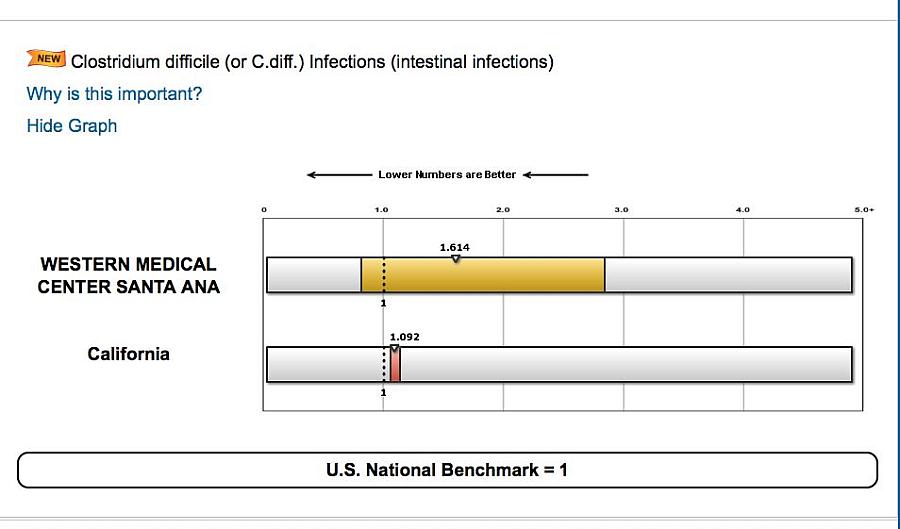Herd Immunity: Feds catch up to California on infection reporting

Image courtesy of Hospital Compare/Centers for Medicare and Medicaid Services
It just got even easier to see whether your hospital has a significant infection problem.
On Friday, the Centers for Medicare and Medicaid Services announced the addition of Clostridium difficile (C. diff) intestinal infections and Methicillin-resistant Staphylococcus aureus (MRSA) blood infections to its Hospital Compare website.
The California Department of Public Health already provides this information on its own My Hospital 411 Infections map. Now all the other states can benefit from the same information.
In fact, if the agencies were racing to provide the most useful information in the easiest to understand format, Hospital Compare just took the lead. As I said last week, I really like the California map. But it only shows three categories: average, higher than average and lower than average.
Hospital Compare shows you the actual infection rate numbers, compared and helpfully color coded against a national infection rate benchmark. Here’s how Hospital Compare explains it:
Healthcare-Associated Infections are reported using a Standardized Infection Ratio (SIR). This calculation compares the number of infections in a hospital to a national benchmark based on data reported to National Healthcare Safety Network (NHSN). Each hospital's SIR is shown in the graph view. Lower numbers are better. A score of zero (0) - meaning no infections - is best.
It also allows you to link to a specific hospital, a feature missing from My Hospital 411. Here’s what I found out about Western Medical Center – Santa Ana. On the state map, it shows that C. diff rates are the same as the US national average. That’s the summary from Hospital Compare, too.
But the Hospital Compare charts provide a fuller picture by providing the actual rates and the confidence intervals. Scientists use confidence intervals to show how much faith they have in an estimate or, flipped around, the amount of uncertainty around an estimate.
See Also: Hospital infections drop after rates go online
When data are scarce, infrequent, or generally unreliable, the confidence intervals are often wider. When data are plentiful, consistent, and repeatedly verified, the confidence intervals are generally narrower. Because Hospital Compare is only reporting infections from one period – the first quarter of 2013 – Hospital Compare is making estimates based on a small amount of data. That’s one of the reasons why the confidence intervals are so wide for so many hospitals on the site. Certain types of conditions are also simply hard to measure, which can lead to more uncertainty around estimates.
Here’s what Hospital Compare says about how it uses the confidence intervals in deciding how to group hospitals.
If the confidence interval for the score falls below 1, then the hospital had fewer infections than similar hospitals.
If the confidence interval for the score includes 1, then the hospital had a comparable number of infections as similar hospitals.
If the confidence interval for the score falls above 1, then the hospital had more infections than similar hospitals.
At Western Medical Center, the confidence interval for C. diff runs from about 0.9 to about 2.9. That means Western Medical Center could be anywhere from a little bit better than the US average to far worse.
The analysis performed for Hospital Compare, though, lands the estimate at 1.614 and, after more data come in over the next few years, we are likely to see that confidence interval narrow.
You can do this type of research now with ease for MRSA, C. diff, central line-associated bloodstream infections, and catheter associated urinary tract infections. You can also see information about surgical site infections from colon surgery and hysterectomy.
Hospital Compare, like My Hospital 411, still could do much more to provide information to the public. But this is a promising start.
It was great to see the posts last week on infection mapping spark so much discussion online. If you have your own ideas on how reporting infection data could lead to better health outcomes, let me know at askantidote [at] gmail.com or via Twitter @wheisel.
Related Links:
California tries to cure prescription drug tracking system

